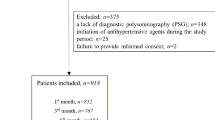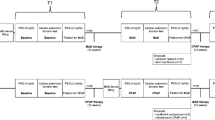Abstract
The objective of the study was to investigate the effects of oral appliance (OA) therapy on ambulatory blood pressure in patients with obstructive sleep apnea (OSA). Eleven OSA patients who received OA therapy were prospectively investigated. Ambulatory blood pressure was measured for 20 h from 4:00 p.m. to 12:00 noon the next day using an ambulatory blood pressure monitor. The Respiratory Disturbance Index (RDI) was measured in the pretreatment and posttitration periods. The OA was titrated to reach a therapeutic jaw position over 2 to 8 months, and posttitration measurements were repeated. At posttitration, the RDI was significantly decreased from a mean (SD) of 24.7 (20.1) to 6.1 (4.5). Significant reductions in diastolic blood pressure (DBP) and mean arterial pressure (MAP) were found for the 20-h periods, and systolic blood pressure (SBP), DBP, and MAP while asleep. The mean values were 79.5 (5.5) to 74.6 (6.0) for DBP and 95.9 (5.4) to 91.2 (5.9) for MAP, for over a 20-h period, and 118.4 (10.0) to 113.7 (9.1) for SBP, 71.6 (8.0) to 67.2 (7.9) for DBP, and 88.4 (8.0) to 83.9 (7.5) for MAP, while asleep. This study suggests that successful OSA treatment with an OA may also be beneficial to lower blood pressure in OSA patients, as previously suggested for nasal continuous positive airway pressure therapy.



Similar content being viewed by others
References
Young T, Palta M, Dempsey J, Skatrud J, Weber S, Badr A (1993) The occurrence of sleep-disordered breathing among middle-aged adults. N Engl J Med 328:1230–1235
Nieto FJ, Young TB, Lind BK, Shahar E, Samet JM, Redline S, D’Agostino RB, Newman AB, Lebowitz MD, Pickering TG (2000) Association of sleep-disordered breathing, sleep apnea, and hypertension in a large community-based study. JAMA 283:1829–1836
Peppard PE, Young T, Palta M, Skatrud J (2000) Prospective study of the association between sleep-disordered breathing and hypertension. N Engl J Med 342(19):1378–1384
Sullivan CE, Issa FG, Berthon-Jones M, Eves L (1981) Reversal of obstructive sleep apnoea by continuous positive airway pressure applied through the nares. Lancet 1(8225):862–865
Randerath WJ, Heise M, Hinz R, Ruehle KH (2002) An individually adjustable oral appliance vs continuous positive airway pressure in mild-to-moderate obstructive sleep apnea syndrome. Chest 122:569–575
Ferguson KA, Ono T, Lowe AA, Keenan SP, Fleetham JA (1996) A randomized crossover study of an oral appliance vs nasal-continuous positive airway pressure in the treatment of mild-moderate obstructive sleep apnea. Chest 109:1269–1275
Ferguson KA, Ono T, Lowe AA, Al-Majed S, Love LL, Fleetham JA (1997) A short term controlled trial of an adjustable oral appliance for the treatment of mild to moderate obstructive sleep apnoea. Thorax 52:362–368
Lowe AA, Sjoholm TT, Ryan CF, Fleetham JA, Ferguson KA, Remmers JE (2000) Treatment, airway and compliance effects of a titratable oral appliance. Sleep 23:S172–S178
Randerath WJ, Heise M, Hinz R, Ruehle KH (2002) An individually adjustable oral appliance vs continuous positive airway pressure in mild-to-moderate obstructive sleep apnea syndrome. Chest 122:569–575
Lowe AA (2000) Oral appliances for sleep breathing disorders. In: Kryger M, Roth T, Dement W (eds) Principles and practice of sleep medicine, 3rd edn. Saunders, Philadelphia, PA, pp 929–939
Gotsopoulos H, Kelly JJ, Cistulli PA (2004) Oral appliance therapy reduces blood pressure in obstructive sleep apnea: a randomized, controlled trial. Sleep 27:934–941
Jennum P, Wildshiodtz G, Christensen NJ, Schwartz T (1989) Blood pressure, catecholamines, and pancreatic polypeptide in obstructive sleep apnea with and without nasal continuous positive airway pressure (nCPAP) treatment. Am J Hypertens 2:847–852
Wilcox I, Grunstein RR, Collins FL, Doyle JM, Kelly DT, Sullivan CE (1992) Circadian rhythm of blood pressure in patients with obstructive sleep apnea. Blood Pressure 1:219–222
Suzuki M, Otsuka K, Guilleminault C (1993) Long-term nasal continuous positive airway pressure administration can normalize hypertension in obstructive sleep apnea patients. Sleep 16:545–549
Engleman HM, Gough K, Martin SE, Kingshott RN, Padfield PL, Douglas NJ (1996) Ambulatory blood pressure on and off continuous positive airway pressure therapy for the sleep apnea/hypopnea syndrome: effects in “non-dippers”. Sleep 19:378–381
Dimsdale JE, Loredo JS, Profant J (2000) Effect of continuous positive airway pressure on blood pressure. Hypertension 35:144–147
Faccenda JF, Mackay TW, Boon NA, Douglas NJ (2001) Randomized placebo-controlled trial of continuous positive airway pressure on blood pressure in the sleep apnea–hypopnea syndrome. Am J Respir Crit Care Med 163:344–348
Chobanian AV, Bakris GL, Black HR, Cushman WC, Green LA, Izzo JL Jr, Jones DW, Materson BJ, Oparil S, Wright JT Jr, Roccella EJ, Joint National Committee on Prevention, Detection, Evaluation, and Treatment of High Blood Pressure, National Heart, Lung, and Blood Institute. National High Blood Pressure Education Program Coordinating Committee (2003) Seventh report of the joint national committee on prevention, detection, evaluation, and treatment of high blood pressure. Hypertension 42:1206–1252
Amoore JN, Dewar D, Gough K, Padfield PL (2005) Do SpaceLabs ambulatory non-invasive blood pressure recorders measure blood pressure consistently over several years use? Blood Press Monit 10(1):51–56
Becker HF, Jerrentrup A, Ploch T, Grote L, Penzel T, Sullivan CE, Peter JH (2003) Effect of nasal continuous positive airway pressure treatment on blood pressure in patients with obstructive sleep apnea. Circulation 107:68–73
Hla KM, Skatrud JB, Finn L, Finn L, Palta M, Young T (2002) The effect of correction of sleep disordered breathing on BP in untreated hypertension. Chest 122:1125–1132
Pepperell JCT, Ramdassingh-Dow S, Crosthwaite N, Mullins R, Jenkinson C, Stradling JR, Davies RJO (2002) Ambulatory blood pressure after therapeutic and subtherapeutic nasal continuous positive airway pressure for obstructive sleep apnoea: a randomized parallel trial. Lancet 359:204–210
Vazquez JC, Tsai WH, Flemons WW, Masuda A, Brant R, Hajduk E, Whitelaw WA, Remmers JE (2000) Automated analysis of digital oximetry in the diagnosis of obstructive sleep apnoea. Thorax 55:302–307
Linden W, Lenz JW, Con AH (2001) Individualized stress management for primary hypertension: randomized trial. Arch Intern Med 161:1072–1080
Acknowledgements
The authors are indebted to Mrs. Ingrid Ellis for her editorial assistance and to Mrs. Mary Wong for her statistical analysis assistance. The authors would like to thank Ms. Y. Erskine and Ms. J. Leclerc, Research Co-ordinators, Behavioural Cardiology, Department of Psychology at The University of British Columbia for their assistance and advice on the ambulatory blood pressure monitoring device used. Klearway was invented by Dr. Alan A. Lowe at The University of British Columbia. International patents have been obtained by The University of British Columbia, and specific licensees are assigned the rights to manufacture and distribute the appliance worldwide. Royalties from the sale of Klearway are paid to The University of British Columbia.
Author information
Authors and Affiliations
Corresponding author
Additional information
This study was conducted in the Division of Orthodontics, The University of British Columbia, Canada
Rights and permissions
About this article
Cite this article
Otsuka, R., Ribeiro de Almeida, F., Lowe, A.A. et al. The effect of oral appliance therapy on blood pressure in patients with obstructive sleep apnea. Sleep Breath 10, 29–36 (2006). https://doi.org/10.1007/s11325-005-0038-6
Published:
Issue Date:
DOI: https://doi.org/10.1007/s11325-005-0038-6




